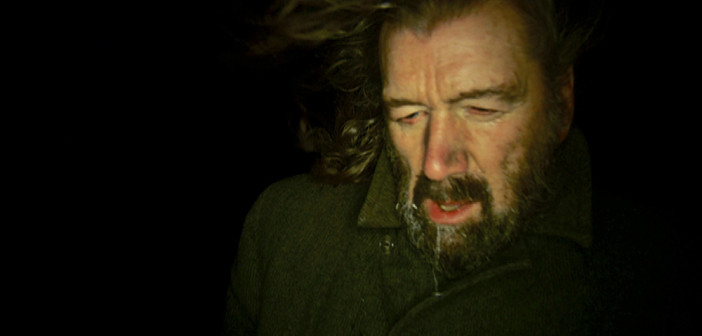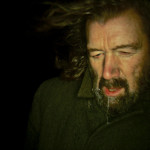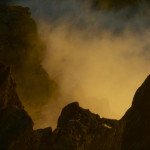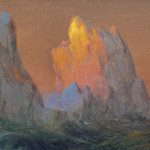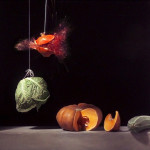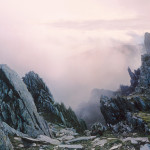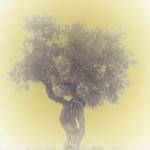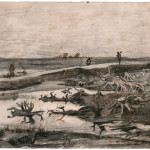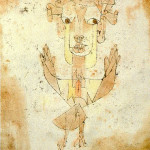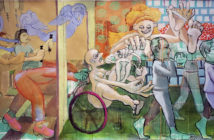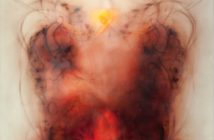Can we be moved by such images now? Gersht seems to think so. But, setting the seductive beauty and exquisite technical prowess aside, I'd like to explore what I found problematic about the exhibition. My reaction stems primarily from two aspects of the show, namely, some of the curatorial decisions and a few of the works themselves.
 Icebergs, 1863
Icebergs, 1863
Frederic Edwin Church (American, 1826—1900). Oil on canvas. Emily L. Ainsley Fund
Photograph © Museum of Fine Arts, Boston
In Gersht's case this placement makes sense to a certain extent: his work draws heavily on the history of painting. The curator, Al Miner, admires Gersht's "bravery that allows him to go head-to-head with some of the greatest painters of the past." But this particular case of juxtaposition causes his work to appear almost entirely reliant on a combination of art historical reference and didactic wall-text to translate his concepts from mere aesthetic effort into the meaningful poetic archive he intends to build with them. And more problematic perhaps, given the symbolism pervading his art, is the meaning imposed onto historic works that never intended to speak for holocaust, since they for the most part predate its most recent and horrific instances and in all cases deal with very different subject matter.
This selection presents as a mid-career retrospective: the works on view span about a decade and only scratch the surface of the artist's total work, or so it seems from the wall labels that place each individual work within a series. Between Places, White Noise, Black Soil, Apocalypse, Ghost, Hide and Seek, Liquidation, Changing Good Fortune: eight photographic series in total, each represented by a single, individual work, makes one ponder whether the man is superhumanly prolific or whether he finishes too easily, failing to flesh out heavy and important concepts. This may be an unfair reflection of an ambitious career and practice now falling on the artist's shoulders because of curatorial choices.
 Olive 11, 2004
Olive 11, 2004
Ori Gersht (Israeli, born in 1967). C-Type Print. Eve Kurtin and Michael Steinberg
© Ori Gersht, Courtesy, Museum of Fine Arts, Boston
Let's instead pause to consider the colored hazes that veil most of the photographs like a gas or a fog. To me, it speaks of concealment. Horror and the resulting trauma is a nausea that follows you everywhere, even into the most beautiful places in nature. Unspeakable deeds disappear under soil, falling leaves, snow, water and the passage of time, yet are never erased from the memory of those who witnessed them. How do you make this invisibility visible to those who haven't? How to evoke the fury one feels riding on the same railroad track as a prisoner convoy once did to a concentration camp? It's not easy, but the fact that Gersht extended the motivations behind his sickeningly pretty photographs into the surface and material comforts me a little.
When Gersht sets paintings in motion, painfully slowly, at times the effect is like a protracted, torturous tear of flesh and a tear on the cheek. Pomegranate is a strong example of this type of video work. No such luck for the narrative video diptych of Jewish-German philosopher Walter Benjamin's last hours.

Angelus Novus. Paul Klee, 1920
Conversely Gersht's 2005 video, The Forest, transported me elsewhere, to histories both personal and universal. I'd happened upon it back in 2005 at the Photographer's Gallery in London, long before I visited Poland, which borders Ukraine with the Białowieża Forest. This was the piece that compelled me to go see the MFA show in the first place, such was its impact back then. Seeing it again in the context of so much slick new work, I fell for its technical imperfections, its simplicity and its individual voice in what elsewhere was a swarm of quotation. I saw the trunks falling, in slow motion, like bodies just shot. I heard the silence, the absence of bird-call, of insects, of voices. I watched the leaves floating downwards covering up the deed. History was repeating and I was its witness.
- Evaders, 2009 Ori Gersht (Israeli, born in 1967). HD film, dual-channel (color, sound) — left screen projection Pizzuti Collection. Ori Gersht © Courtesy Museum of Fine Arts, Boston
- Evaders, 2009 Ori Gersht (Israeli, born in 1967). HD film, dual-channel (color, sound) — right screen projection Pizzuti Collection. Ori Gersht © Courtesy Museum of Fine Arts, Boston
- Icebergs, 1863 Frederic Edwin Church (American, 1826—1900). Oil on canvas. Emily L. Ainsley Fund Photograph © Museum of Fine Arts, Boston
- Pomegranate, 2006 Ori Gersht (Israeli, born in 1967). HD film (color, sound) The Jewish Museum, New York. Purchase: Nathan and Jacqueline Goldman and Simon Lissim Funds, by exchange, 2008-219. Ori Gersht © Courtesy Museum of Fine Arts, Boston
- Far Off Mountains and Rivers, 2009 Ori Gersht (Israeli, born in 1967). Lightjet Print. Robert and Alicia Wykoff Ori Gersht © Courtesy Museum of Fine Arts, Boston
- Olive 11, 2004 Ori Gersht (Israeli, born in 1967). C-Type Print Eve Kurtin and Michael Steinberg. © Ori Gersht Courtesy, Museum of Fine Arts, Boston
- Landscape with Bog Trunks (Travaux aux Champs) Vincent van Gogh (Dutch (worked in France), 1853—1890), October, 1883 Graphite pencil with pen and brown ink on paper. Gift of John Goelet. Photograph © Museum of Fine Arts, Boston
- Angelus Novus Paul Klee, 1920
"History Repeating" is on view August 25, 2012 to January 6, 2013 in the MFA's Foster Gallery.
Image credits are stated in each caption.

